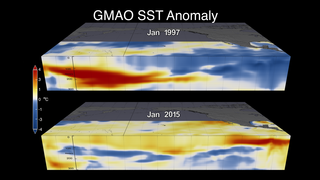Earth
ID: 12199
Every two to seven years, an unusually warm pool of water—sometimes two to three degrees Celsius higher than normal—develops across the eastern equatorial Pacific Ocean. This warm condition, known as El Niño, can disrupt marine ecosystems and spur extreme weather patterns around the world. To predict when an El Niño is coming, NASA scientists use computer models that simulate ocean temperatures in the Pacific. Changes in ocean temperatures typical of an El Niño occur on the sea surface and up to 1,000 feet deep. With inputs from ocean buoys, satellite data and other sources, the models show what ocean temperatures might look like months into the future. The information not only helps scientists estimate the strength of an El Niño, but also study its evolution.
Evolution of Pacific Ocean Temperatures
Related
Credits
Kayvon Sharghi (USRA): Lead Producer
Sophia Roberts (USRA): Producer
Robin Kovach (SSAI): Scientist
John Caldwell (Advocates in Manpower Management, Inc.): Videographer
Sophia Roberts (USRA): Producer
Robin Kovach (SSAI): Scientist
John Caldwell (Advocates in Manpower Management, Inc.): Videographer
Please give credit for this item to:
NASA's Goddard Space Flight Center
NASA's Goddard Space Flight Center
Short URL to share this page:
https://svs.gsfc.nasa.gov/12199
This item is part of this series:
Narrated Movies
Keyword:
NASA Science >> Earth
https://svs.gsfc.nasa.gov/12199
This item is part of this series:
Narrated Movies
Keyword:
NASA Science >> Earth












